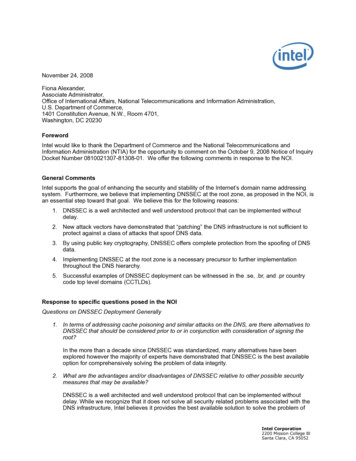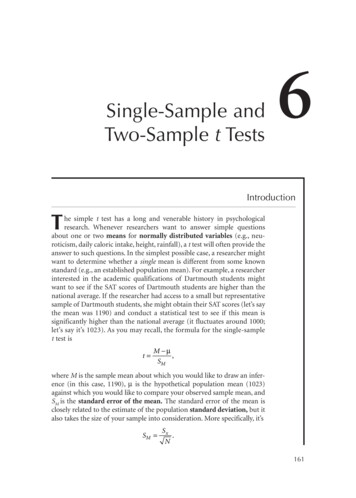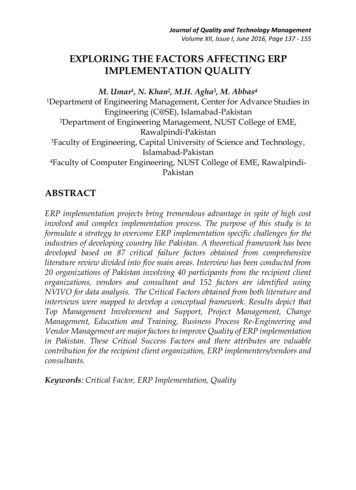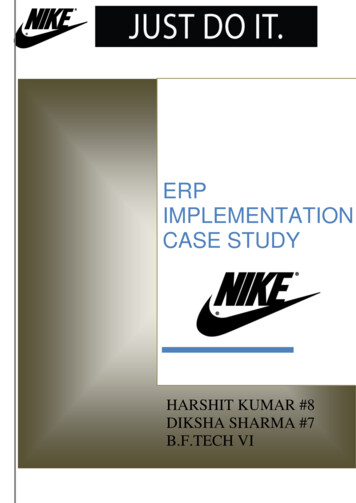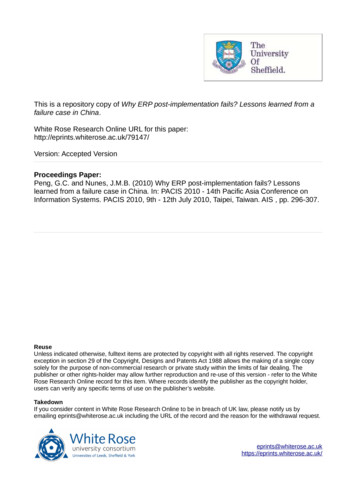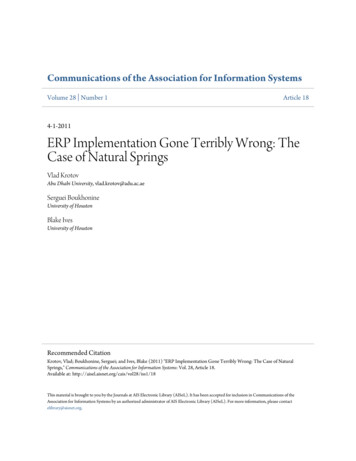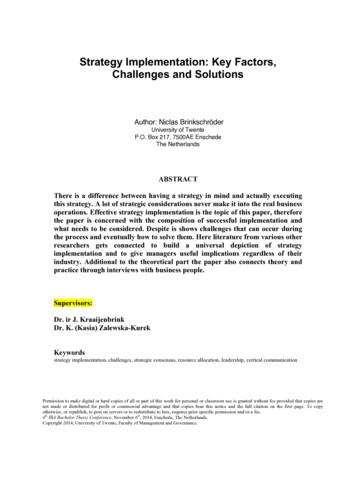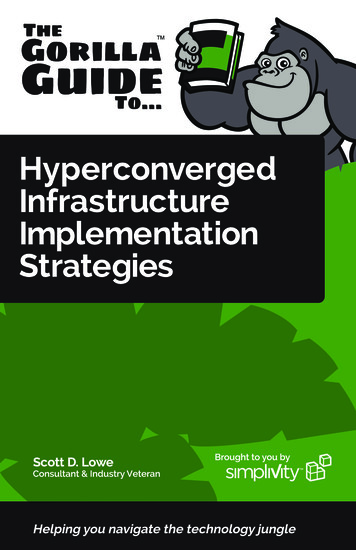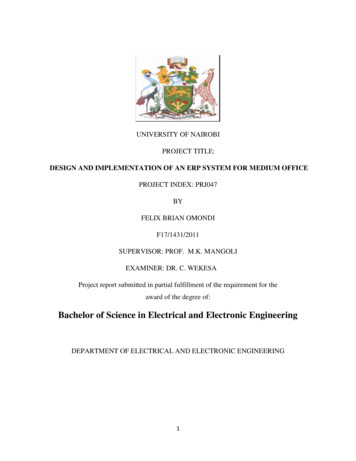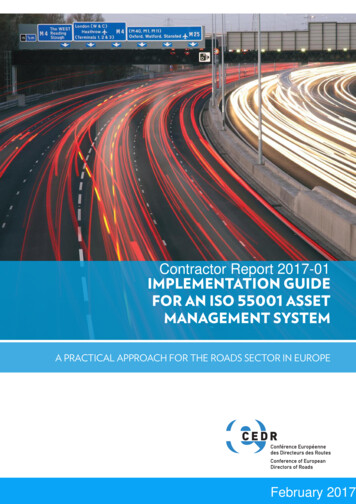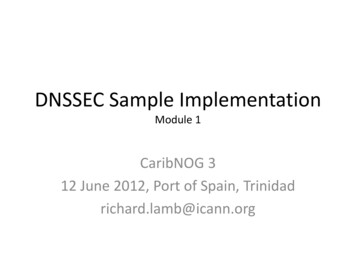
Transcription
DNSSEC Sample ImplementationModule 1CaribNOG 312 June 2012, Port of Spain, Trinidadrichard.lamb@icann.org
DNSSEC: Where we are Deployed on 87/313 TLDs (.uk, .fr, .asia, .in, .lk,.kg, .tm, .am, .tw 台灣 台湾, .jp, .cr, .com, ) Root signed and audited 84% of domain names could have could haveDNSSEC deployed on them Large ISP has turned DNSSEC validation “on”* A few 3rd party signing solutions (e.g., GoDaddy,VeriSign, Binero, ) Unbound, BIND, DNSSEC-trigger, vsResolver andother last mile. DANE work almost done*All 18M COMCAST Internet customers. Others.TeliaSonera SE,Vodafone CZ,Telefonica, CZ, T-mobile NL, SurfNet NL
Game changing Internet CoreInfrastructure Upgrade “More has happened here today than meetsthe eye. An infrastructure has been createdfor a hierarchical security system, which canbe purposed and re‐purposed in a number ofdifferent ways. .” – Vint Cerf
Resultant Global PKISSL (DANE), E-mail, VOIP security DNSSEC root - 1CA Certificate roots 1482Content securityCommercial SSLCertificates forWeb and e-mailYet to be discoveredsecurity innovations,enhancements, andsynergiesContent security“Free SSL”certificates for Weband e-mail and “trustagility” (DANE)Network securityIPSECKEY RFC4025Securing VoIPDomain ssorganizational andtrans-nationalidentity andauthenticationE-mail securityDKIM RFC4871Login securitySSHFP RFC4255
Design Considerations
Goals Reliable Trusted Cost Effective (for you)
Cost Effectiveness
Cost Effectiveness Risk Assessment Cost Benefit Analysis
Business Benefits and Motivation(from “The Costs of DNSSEC Deployment” ENISA report) Become a reliable source of trust and boost marketshare and/or reputation of zones; Lead by example and stimulate parties further downin the chain to adopt DNSSEC; Earn recognition in the DNS community and shareknowledge with TLD’s and others; Provide assurance to end-user that domain nameservices are reliable and trustworthy; Look forward to increasing adoption rate whenrevenue is an important driver. Deploying DNSSECcan be profitable;
Risk Assessment Identify your risks– Reputational– Competition– Loss of contract– Legal / Financial– Who is the relying party?– SLA– Law suits Build your risk profile– Determine your acceptable level of risk
Vulnerabilities False expectationsKey compromiseSigner compromiseZone file compromise
Cost Benefit AnalysisSetting reasonable expectations meansit doesn’t have to be expensive
From ENISA Report “ .organizations considering implementing DNSSECcan greatly benefit from the work performed by thepioneers and early adopters.” Few above 266240 Euros: Big Spenders: DNSSEC asan excuse to upgrade all infrastructure; embraceincreased responsibility and trust through bettergovernance. Most below 36059 Euros: Big Savers: reuse existinginfrastructure. Do minimum.
Anticipated Capital and OperatingExpense Being a trust anchor requires mature businessprocesses, especially in key management; Investment cost also depends on strategicpositioning towards DNSSEC: leaders pay thebill, followers can limit their investment; Financial cost might not outweigh thefinancial benefits. Prepare to write off thefinancial investment over 3 to 5 years, neededto gear up end-user equipment with DNSSEC.
Other Cost Analysis People– Swedebank – half a FTE– Occasional shared duties for others Facilities– Datacenter space– Safe 100 - 14000 Crypto Equip 5- 40000 Bandwidth 4 rnetdagarna.se/images/stories/doc/22 Kjell Rydger DNSSEC from a bank perspective 200810-20.pdf
Trusted
Trust Transparent Secure
Transparency
Transparency The power of truth Transparency floats all boats here Say what you do Do what you say Prove it
Say what you do Setting expectationsDocument what you do and how you do itMaintain up to date documentationDefine Organization Roles and responsibilitiesDescribe Services, facilities, system, processes,parameters
Learn from CA successes (andmistakes) The good:–––––The peopleThe mindsetThe practicesThe legal frameworkThe audit against international accounting and technicalstandards The bad:– Diluted trust with a race to the bottom ( 1400 CA’s)– DigiNotar Weak and inconsistent polices and controls Lack of compromise notification (non-transparent) Audits don’t solve everything (ETSI audit)
Say What You Do - Learn fromExisting Trust Services Borrow many practices from SSL CertificationAuthorities (CA) Published Certificate Practices Statements (CPS)– VeriSign, GoDaddy, etc. Documented Policy and Practices (e.g., keymanagement ceremony, audit materials,emergency procedures, contingency planning,lost facilities, etc )
Say What You Do - DNSSECPractices Statement DNSSEC Policy/Practices Statement (DPS)– Drawn from SSL CA CPS– Provides a level of assurance and transparency tothe stakeholders relying on the security of theoperations.– Regular re-assessment– Management signoff Formalize - Policy Management Authority (PMA)
Documentation - Root91 Pages andtree of otherdocuments!Root DPS
Documentation - .SE22 pages, CreativeCommons License!.SE DPS
Do what you say Follow documented procedures / checklists Maintain logs, records and reports of eachaction, including incidents. Critical operations at Key Ceremonies– Video– Logged– Witnessed
Key CeremonyA filmed and audited process carefullyscripted for maximum transparency atwhich cryptographic key material isgenerated or used.
Prove it Audits–3rd party auditor –ISO 27000 etc.–Internal
Prove it - Audit Material Key Ceremony ScriptsAccess Control System logsFacility, Room, Safe logsVideoAnnual InventoryLogs from other Compensating ControlsIncident Reports
Prove it Stakeholder Involvement–Publish updated material and reports–Participation, e.g. External Witnessesfrom–local Internet community–Government–Listen to Feedback
Prove it Be Responsible–Executive Level Involvement In policies via Policy ManagementAuthority Key Ceremony participation
Security
Security Physical Logical Crypto
Physical– Environmental– Tiers– Access Control– Intrusion Detection– Disaster Recovery
Physical - Environmental Based on your risk profile Suitable– Power– Air Conditioning Protection from– Flooding– Fire– Earthquake
Physical - Tiers Each tier should be successively harder topenetrate than the last– Facility– Cage/Room– Rack– Safe– System Think of concentric boxes
Physical - Tier Construction Base on your risk profile and regulations Facility design and physical security on– Other experience– DCID 6/9– NIST 800-53 and related documents– Safe / container standards
Physical – Safe Tier
Physical – Safe Tier
Physical - Access Control Base on your risk profile Access Control System– Logs of entry/exit– Dual occupancy / Anti-passback– Allow Emergency Access High Security: Control physical access tosystem independent of physical accesscontrols for the facility
Physical - Intrusion Detection Intrusion Detection System– Sensors– Motion– Camera Tamper Evident Safes and Packaging Tamper Proof Equipment
Physical - Disaster Recovery Multiple sites– Mirror– Backup Geographical and Vendor diversity
Logical Authentication (passwords, PINs) Multi-Party controls
Logical - Authentication Procedural:– REAL passwords– Forced regular updates– Out-of-band checks Hardware:– Two-factor authentication– Smart cards (cryptographic)
Logical - Multi-Party Control Split Control / Separation of Duties– E.g., Security Officer and System Admin and SafeController M-of-N– Built in equipment (e.g. HSM)– Procedural: Split PIN– Bolt-On: Split key (Shamir, e.g. ssss.c)
Crypto Algorithms / Key Length Crypto Hardware
Crypto - Algorithms / Key Length Factors in selection– Cryptanalysis– Regulations– Network limitations
Crypto - Key Length Cryptanalysis from NIST: 2048 bit RSA 00-57/sp800-57 PART3 keymanagement Dec2009.pdf
Crypto - Algorithms Local regulations may determine algorithm– GOST– DSA Network limitations– Fragmentation means shorter key length is better– ZSK may be shorter since it gets rolled often– Elliptical is ideal – but not available yet
Crypto - Algorithms NSEC3 if required– Protects against zone walking– Avoid if not needed – adds overhead for smallzones– Non-disclosure agreement?– Regulatory requirement?– Useful if zone is large, not trivially guessable (only“www” and “mail”) or structured (ip6.arpa), andnot expected to have many signed delegations(“opt-out” avoids recalculation).
Crypto - Hardware Satisfy your stakeholders– Doesn’t need to be certified to be secure (e.g., off-line PC)– Can use transparent process and procedures to instill trust– But most Registries use or plan to use HSM. Maybe CYA? AT LEAST USE A GOOD Random Number Generator(RNG)! Use common standards avoid vendor lock-in.– Note: KSK rollover may be 10 years. Remember you must have a way to backup keys!
Crypto - Hardware Security Module(HSM) FIPS 140-2 Level 3– Sun SCA6000 ( 30000 RSA 1024/sec) 10000 (was 1000!!)– Thales/Ncipher nshield ( 500 RSA 1024/sec) 15000 FIPS 140-2 Level 4– AEP Keyper ( 1200 RSA 1024/sec) 15000– IBM 4765 ( 1000 RSA 1024/sec) 9000 Recognized by your national certification authority– Kryptus (Brazil) 2500Study: df
Crypto - PKCS11 A common interface for HSM and smartcards– C Sign()– C GeneratePair() Avoids vendor lock-in - somewhat Vendor Supplied Drivers (mostly Linux,Windows) and some open source
Crypto - Smartcards / Tokens Smartcards (PKI) (card reader 20)– Oberthur 5- 15– AthenaSC IDProtect 35– Feitian 5-10 Token– Aladdin/SafeNet USB e-Token 50– SDencrypter micro HSM www.go-trust.com Open source PKCS11 Drivers available– OpenSC Has RNG Slow 0.5-10 1024 RSA signatures per second
Crypto -Random Number Generator rand()Netscape: Date PIDsLavaRandSystem Entropy /dev/randomQuantum Mechanical Standards based (FIPS, NIST 800-90 DRBG)Coming soon: Intel atomic
Crypto - FIPS 140-2 Level 4 HSMRoot, .FR,
Crypto – FIPS Level 3 HSM But FIPS 140-2 Level 3 is also common Many TLDs using Level 3 .com , .se, .uk, .com,etc 10K- 40KHSMs (ENISA)
An implementation can be thi
Physical Security
45698/
Key Rollover Schedule - Roothttps://www.iana.org/dnssec
or this
.or this (from .cr)Sign ZSKswith KSKTransport KSKsignedDNSKEYRRsetsOffline Laptopwith TPMunsignedzoneOnline/off-netDNSSECSigner withTPMKSKGenerateKSKSecure OfflineEnvironmentSign zoneswith ZSKTransportpublic halfof ZSKsZSKsGenerateZSKssignedzone
Demo ImplementationKey lengths – KSK:2048 RSA ZSK:1024 RSARollover – KSK:as needed ZSK:90 daysRSASHA256 NSEC3Physical – HSM/smartcards inside Safe inside Rack inside Cageinside Commercial Data Center Logical – Separation of roles: cage access, safe combination,HSM/smartcard activation across three roles Crypto – use FIPS certified smartcards as HSM and RNG – Generate KSK and ZSK offline using RNG– KSK use off-line– ZSK use off-net
Off-Line Key generator and KSKSignerDATA CENTERCAGERACKSAFEsmartcardsLive O/S DVDKSK RNGKSK RNGKSK RNGreaderlaptopFlash DriveKSK signedDNSKEYsEncryptedZSKs
Off-Net SignerDATA CENTERCAGERACKzonefilehiddenmasterFlash DriveKSK erfirewallhiddenmasternameserver
Key ManagementSign ZSKs withKSKOffline LaptopKSKGenerate ZSKsGenerate KSKSecure KeyGeneration andSigningEnvironmentTransport KSKsignedDNSKEYRRsetsand rSign zoneswith ZSKsignedzone
– AthenaSC IDProtect 35 – Feitian 5-10 Token – Aladdin/SafeNet USB e -Token 50 – SDencrypter micro HSM www.go -trust.com Open source PKCS11 Drivers available – OpenS
